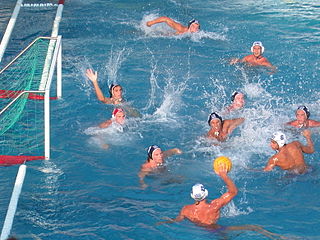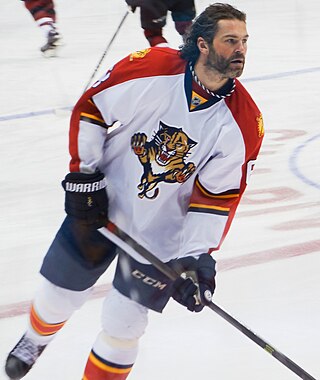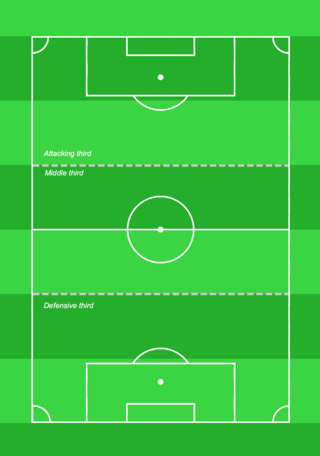Related Research Articles

Ice hockey is a team sport played on ice skates, usually on an ice skating rink with lines and markings specific to the sport. It belongs to a family of sports called hockey. In ice hockey, two opposing teams use ice hockey sticks to control, advance, and shoot a closed, vulcanized, rubber disc called a "puck" into the other team's goal. Each goal is worth one point. The team which scores the most goals is declared the winner. In a formal game, each team has six skaters on the ice at a time, barring any penalties, one of whom is the goaltender. Ice hockey is a full contact sport, and is considered to be one of the more physically demanding team sports. It is distinct from field hockey, in which players move a ball around a non-frozen pitch using field hockey sticks.

Water polo is a competitive team sport played in water between two teams of seven players each. The game consists of four quarters in which the teams attempt to score goals by throwing the ball into the opposing team's goal. The team with the most goals at the end of the game wins the match. Each team is made up of six field players and one goalkeeper. Excluding the goalkeeper, players participate in both offensive and defensive roles. It is typically played in an all-deep pool where players cannot touch the bottom.

In many team sports, defense or defence is the action of preventing an opponent from scoring. The term may also refer to the tactics involved in defense, or a sub-team whose primary responsibility is defense. Similarly, a defense player or defender is a player who is generally charged with preventing the other team's forwards from being able to bear down directly on their own team's goalkeeper or goaltender. Such positions exist in association football, ice hockey, water polo and many other sports.

The centre in ice hockey is a forward position of a player whose primary zone of play is the middle of the ice, away from the sideboards. Centres have more flexibility in their positioning and therefore often end up covering more ice surface than any other player. Centres are ideally strong, fast skaters who are able to backcheck quickly from deep in the opposing zone. Generally, centres are expected to be gifted passers more so than goal scorers, although there are exceptions - typically larger centres who position themselves directly in front of the net in order to score off rebounds. They are also expected to have exceptional "ice vision", Hockey IQ, intelligence, and creativity. They also generally are the most defensively-oriented forwards on the ice, as they are expected to play the role of the third player in defense, after the defencemen. Centres usually play as part of a line of players that are substituted frequently to keep fresh and keep the game moving.

Winger, in the game of ice hockey, is a forward position of a player whose primary zone of play is along the outer playing areas. They typically flank the centre forward. Originally the name was given to forward players who went up and down the sides of the rink. Wingers generally have the least defensive responsibilities out of any position on the ice, however they are still tasked with defensive duties such as forechecking duties or covering the point in the defensive zone.

Defence or defense in ice hockey is a player position that is primarily responsible for preventing the opposing team from scoring. They are often referred to as defencemen, D, D-men or blueliners. They were once called cover-point.

The neutral zone trap is a defensive strategy used in ice hockey to prevent an opposing team from proceeding through the neutral zone and to force turnovers.
The point is a term in ice hockey to indicate a position inside the opposition's blue line along the edges of the rink.

Team tactics as well as individual skills are integral for playing association football. In theory, association football is a very simple game, as illustrated by Kevin Keegan's namely assertion that his tactics for winning a match were to "score more goals than the opposition". Tactical prowess within the sport is nonetheless a craftsmanship of its own, and one of the reasons why managers are paid well on the elite level. Well-organised and ready teams are often seen beating teams with more skillful players on paper. Manuals and books generally cover not only individual skills but tactics as well.

In the sport of association football, each of the 11 players on a team is assigned to a particular position on the field of play. A team is made up of one goalkeeper and ten outfield players who fill various defensive, midfield, and attacking positions depending on the formation deployed. These positions describe both the player's main role and their area of operation on the pitch.
In sports, a utility player is one who can play several positions competently. Sports in which the term is often used include association football, basketball, American football, baseball, rugby union, rugby league, softball, ice hockey, and water polo.
In ice hockey, a play is offside if a player on the attacking team does not control the puck and is in the offensive zone when a different attacking player causes the puck to enter the offensive zone, until either the puck or all attacking players leave the offensive zone. Simply put, the puck must not enter the attacking zone after attacking players. If a player on the attacking team is in the offensive zone before the puck, either an immediate offside occurs, or they must retreat to the neutral zone.

In basketball, there are five players on court per team, each assigned to positions. Historically, these players have been assigned to positions defined by the role they play on the court, from a strategic point of view. The three main positions are guard, forward, and center, with the standard team featuring two guards, two forwards, and a center. Over time, as more specialized roles developed, each of the guards and forwards came to be differentiated, and today each of the five positions is known by a unique name and number: point guard (PG) or 1, the shooting guard (SG) or 2, the small forward (SF) or 3, the power forward (PF) or 4, and the center (C) or 5.
Zone defense is a type of defense, used in team sports, which is the alternative to man-to-man defense; instead of each player guarding a corresponding player on the other team, each defensive player is given an area to cover.

The Miracle on Manchester is the nickname given to a National Hockey League (NHL) playoff game between the Los Angeles Kings and Edmonton Oilers that took place on April 10, 1982 in the league's 65th season. The game, the third in a best-of-five postseason series, was played at The Forum, the Kings' home arena at the time, which was situated on Manchester Boulevard in the Los Angeles suburb of Inglewood. The Kings completed the largest comeback in NHL playoff history, going from being down 5–0 to win the game in overtime, 6–5. Combined with upset wins in Games 1 and 5, the Kings eliminated the Gretzky-led Oilers in a 3–2 series victory to reach the second round.
This is a list of common terms used in the sport of ice hockey along with the definitions of these terms.
In ice hockey, a line is a group of forwards who play in a group, or "shift", during a game.
The forecheck is an ice hockey defensive coverage play made (primarily) in the offensive zone with the objective of applying pressure to the opposing team to regain control of the puck. It is a type of checking. Forechecking is generally executed in one of three situations: recovery of the puck after a dump in, after the rebound following a scoring attempt, or immediately after a turnover to regain possession. Forechecking can be aggressive or conservative depending on the coaching style and on the skating skills of the players.
The game of lacrosse is played using a combination of offensive and defensive strategies. Offensively, the objective of the game is to score by shooting the ball into an opponent's goal, using the lacrosse stick to catch, carry, and pass the ball. Defensively, the objective is to keep the opposing team from scoring and to dispossess them of the ball through the use of stick checking and body contact or positioning.
The 2-1-2 forecheck, or pinch on a wide rim is an ice hockey forechecking strategy which uses two forwards deep in the offensive zone, with the remaining forward positioned high in the offensive zone, and the two defencemen positioned at the highest part of the zone near the blue line. This forecheck is used to apply both mental and physical pressure on the opposing team as they try to move the puck out of their defensive zone with objective of forcing a turnover. The positioning of the players removes options for moving the puck along the boards, forcing the play to the middle.
References
- ↑ Fishman, Jon M. (2019). Hockey's G. O. A. T.: Wayne Gretzky, Sidney Crosby, and More. Lerner Publishing Group. ISBN 978-1-5415-7444-1.
- ↑ Falla, Jack (1993-07-01). Hockey: Learn to Play the Modern Way. Sports Illustrated. ISBN 978-1-4616-6442-0.
- ↑ Shorey, John (1995). Hockey Made Easy : Instructional Manual. Hockey Made Easy. ISBN 978-0-9680461-0-4.
- ↑ Skahan, Sean (2016-02-17). Total Hockey Training. Human Kinetics. ISBN 978-1-4925-8532-9.
